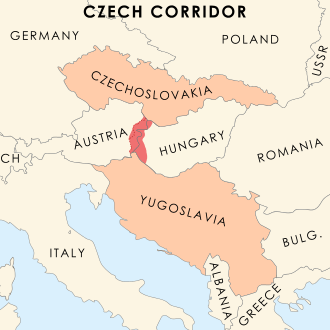Czech Corridor

The Czech Corridor was a failed proposal during the Paris Peace Conference of 1919 in the aftermath of World War I. The proposal would have carved out an area of land to connect the Kingdom of Yugoslavia and Czechoslovakia. A different name often given is Czech–Yugoslav Territorial Corridor. It is called the Czech Corridor, because representatives of Yugoslavia at the Peace Conference stated that they would prefer it be given to the Czechs. The proposal was rejected by the conference.
The corridor would have consisted of Burgenland, and other areas that would be found along the future border of Austria and Hungary. The area is sometimes called Western Transdanubia. In a February 1916 memorandum to the French government, Tomas Masaryk stated that the corridor would correct "The division of the Czechoslovaks and Yugoslavs"[1] arising from the 9th century Hungarian invasion.
The corridor would be 200 kilometers long and 80 kilometers wide. The corridor would have cut through four Hungarian counties, Moson, Sopron, Vas and Zala. However, there exist variant proposals that would have made the area significantly larger.
It is unlikely that the Slavic states could have gotten this proposal accepted using the principles of self-determination, since of the 1,171,000 people living in the area, 662,000 were Hungarians, 220,000 were Slavs and 289,000 others (mostly Germans). According to the Czechs, the main purpose of the corridor was to separate the Germans from East and Central Europe. They also mentioned that this would benefit the French. Most speculate that it was intended to give Czechoslovakia a larger share of the Danube in order to make Bratislava into a great Danube harbor; this would have isolated Hungary even more. The Czechoslovak delegates claimed that Bratislava was the ancient capital of Slovakia, omitting the fact that Bratislava was for four centuries the capital of Hungary.
This proposal was supported by supporters of pan-Slavic ideology as it would have created a joint border between two states that represented Slavic unity (Czechoslovakia and the Kingdom of Serbs, Croats and Slovenes). Even more pan-Slavic supporters said that it would connect the Northern (Western Slavs) with the Southern Slavs. This idea was also supported by Croat nationalists who wanted the Croats living in Burgenland and those Croats living in a couple of villages in Slovakia to be part of the Yugoslav state.[2] The existence of such an area was supported by those who believed that since Austria-Hungary no longer existed, there should be no reason for Austria and Hungary to share a border.
See also
References
- ↑ Oskar Krejčí, Martin C. Styan: Geopolitics of the Central European Region, 2005, ISBN 80-224-0852-2, ISBN 978-80-224-0852-3
- ↑ Arnold Suppan: Jugoslawien und Österreich 1918-1938 Seite 563f Oldenbourg Wissenschaftsverlag, 1996
Further reading
- Margaret MacMillan, Richard Holbrooke: Paris 1919: Six Months that Changed the World, Random House, 2002. ISBN 0-375-76052-0
- Oskar Krejčí, Martin C. Styan: Geopolitics of the Central European Region, 2005, ISBN 80-224-0852-2, ISBN 978-80-224-0852-3
- Janko Bekić: Die Entstehung der Ersten Tschechoslowakischen Republik und die Pläne zur Errichtung eines "Slawischen Korridors", Wien, Univ., Dipl.-Arb., 2006, AC05316414
External links
- Chronological survey of the Burgenland Croats
- Essay: "EVENTS LEADING TO TRIANON" by László Botos
- Map